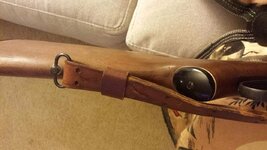- Messages
- 33
- Reactions
- 7
I just bought a Marlin 336 .35 Remington.
Stamped on the Rifle:
The Marlin Firearms Co. New Haven Conn. U.S.A
EST. 1870-Model 336 R.C.CAL. .35 REM. -Micro-Groove Barrel
There is also a small JM stamped on the barrel.
I would greatly appreciate any info you know about this rifle.
I picked it up for $260. Good Deal? I'm in love with lever actions. Didn't think, just paid the man. ha.
Thanks!
Stamped on the Rifle:
The Marlin Firearms Co. New Haven Conn. U.S.A
EST. 1870-Model 336 R.C.CAL. .35 REM. -Micro-Groove Barrel
There is also a small JM stamped on the barrel.
I would greatly appreciate any info you know about this rifle.
I picked it up for $260. Good Deal? I'm in love with lever actions. Didn't think, just paid the man. ha.
Thanks!
















